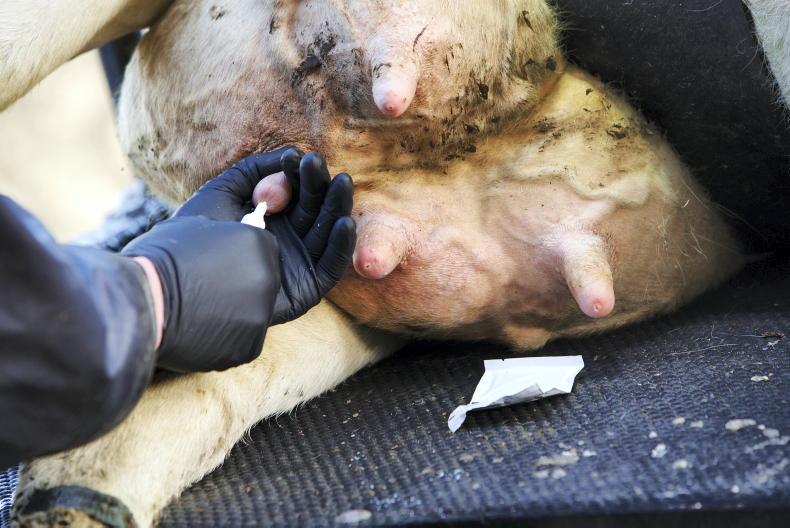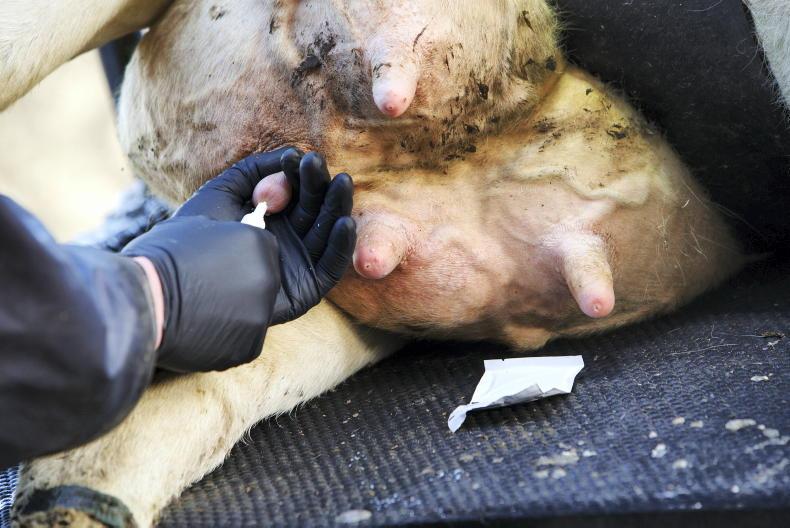A successful drying off and dry period is one where we can prevent cows from picking up new mastitis infections.
Minimising the exposure of cows’ teats to bacteria is the main aim, so good hygiene and management practices are crucial.
Research has shown that over 50% of mastitis cases in early lactation were acquired during drying off or the dry period. Hence, what happens at this time can make or break the next season; let’s start thinking about drying off as the first job of 2024 and not the last job of 2023.
The new Veterinary Medicine Regulations came into effect in January 2022. The key goal of this regulation is to protect human health by reducing the risk of antimicrobial resistance (AMR) developing.
Prescribing antibiotics must now happen at an individual cow level, and not at a herd level.
Only cows with evidence of infection should be treated with antibiotics at drying off; using antibiotics to prevent infections or to compensate for insufficient housing or management is no longer acceptable.
This means moving away from whole herd treatment (blanket dry-cow therapy) to individual cow treatment, and that we must adopt ‘selective dry cow therapy’ (SDCT), which involves a more targeted use of antibiotic treatments.
Internal teat sealer is used in the remainder of the herd as one of the measures to prevent new infections during the dry period. Good records are key to identifying infected cows and to ensuring the vet has sufficient information to prescribe appropriately.
While last autumn was the first time spring-calving herds were required to implement SDCT, this year, the Department will begin carrying out inspections of veterinary practices and related farms to ensure appropriate prescribing practices.
While a selective drying-off strategy is considered a more prudent use of antibiotics, this practice is not without risk and is not something to embark on without preparation and professional support. If we inadvertently introduce bacteria into the cow’s udder during the drying-off process, cows that have been treated with teat seal only at drying off are particularly vulnerable, as there is no antibiotic to “protect” them.
Those cows are also vulnerable if bacteria gain access when the teat canals are open. This is why hygienic practices during drying off and the dry period are essential.
Advanced preparation
Good preparation is key to a successful drying-off event and planning should begin at least one month before you aim to start.
It is important that cows have an adequate dry period of at least six – but preferably eight – weeks. This allows the udder enough time to repair and for cows to rejuvenate, and it is especially important in thin or young cows.
Here, this article goes into the different stages of preparation you should aim to go through with your herd in order to keep your cows adequately protected during the drying-off period. You can also watch this video on drying off for tips.
One month before
drying off:
Milk record within a month of drying off to identify cows with a high SCC. Cows with persistently elevated SCC are a risk to others and often have poor cure rates, so may need to be culled.Collect sterile samples from a selection of high-SCC cows, including old, young, recently infected and chronic cows, to get a profile of the types of bacteria existing in the herd. The real value of susceptibility testing is to identify any resistance, and thus, what product not to use.It is important that time is put aside to discuss records and the drying-off procedure with your adviser and vet. Review expected calving dates, to ensure an adequate dry period is achieved (minimum six to eight weeks; longer in young or thin cows).One week before drying off:
Manage production levels; where cows are yielding greater than 12 litres/day in the week before planned drying off, reduce feed intake, but not water access. Clip cows’ tails and rear udders to ensure better hygiene. Avoid skipping milkings in the days leading up to drying off – cows should be dried off abruptly.Drying-off procedure:
Sterilise the teat ends by vigorously rubbing the teat opening with a teat wipe or an alcohol-soaked cotton ball (70% alcohol) for at least 10 seconds. Repeat as necessary until no more dirt is seen on the wipe/cotton ball. Sterilise the two teats furthest away first (front teats) and then the two closest (rear teats), to avoid brushing against the sterilised teats.Administer the tubes in reverse, ie, treat the two closest teats first, followed by the two furthest away. Remove the cap of the tube and, without touching its tip, gently insert the nozzle into the teat canal. Massage the dry-cow antibiotic up into the quarter, but DO NOT massage the teat sealant. Teat sealant must remain within the bottom part of the teat to create an effective barrier. Teats should be disinfected well after drying off. Forearms and gloved hands should be cleaned in between treating the cows, and if gloves are damaged, they should be replaced.The parlour should be cleaned between batches to reduce the risk of contamination. To avoid errors, good identification of cows and accurate record-keeping are critically important. Following drying off:
Keep the cows standing for a minimum of 30 minutes in a clean environment, like a nearby dry field or clean cubicles.
A successful drying off and dry period is one where we can prevent cows from picking up new mastitis infections.
Minimising the exposure of cows’ teats to bacteria is the main aim, so good hygiene and management practices are crucial.
Research has shown that over 50% of mastitis cases in early lactation were acquired during drying off or the dry period. Hence, what happens at this time can make or break the next season; let’s start thinking about drying off as the first job of 2024 and not the last job of 2023.
The new Veterinary Medicine Regulations came into effect in January 2022. The key goal of this regulation is to protect human health by reducing the risk of antimicrobial resistance (AMR) developing.
Prescribing antibiotics must now happen at an individual cow level, and not at a herd level.
Only cows with evidence of infection should be treated with antibiotics at drying off; using antibiotics to prevent infections or to compensate for insufficient housing or management is no longer acceptable.
This means moving away from whole herd treatment (blanket dry-cow therapy) to individual cow treatment, and that we must adopt ‘selective dry cow therapy’ (SDCT), which involves a more targeted use of antibiotic treatments.
Internal teat sealer is used in the remainder of the herd as one of the measures to prevent new infections during the dry period. Good records are key to identifying infected cows and to ensuring the vet has sufficient information to prescribe appropriately.
While last autumn was the first time spring-calving herds were required to implement SDCT, this year, the Department will begin carrying out inspections of veterinary practices and related farms to ensure appropriate prescribing practices.
While a selective drying-off strategy is considered a more prudent use of antibiotics, this practice is not without risk and is not something to embark on without preparation and professional support. If we inadvertently introduce bacteria into the cow’s udder during the drying-off process, cows that have been treated with teat seal only at drying off are particularly vulnerable, as there is no antibiotic to “protect” them.
Those cows are also vulnerable if bacteria gain access when the teat canals are open. This is why hygienic practices during drying off and the dry period are essential.
Advanced preparation
Good preparation is key to a successful drying-off event and planning should begin at least one month before you aim to start.
It is important that cows have an adequate dry period of at least six – but preferably eight – weeks. This allows the udder enough time to repair and for cows to rejuvenate, and it is especially important in thin or young cows.
Here, this article goes into the different stages of preparation you should aim to go through with your herd in order to keep your cows adequately protected during the drying-off period. You can also watch this video on drying off for tips.
One month before
drying off:
Milk record within a month of drying off to identify cows with a high SCC. Cows with persistently elevated SCC are a risk to others and often have poor cure rates, so may need to be culled.Collect sterile samples from a selection of high-SCC cows, including old, young, recently infected and chronic cows, to get a profile of the types of bacteria existing in the herd. The real value of susceptibility testing is to identify any resistance, and thus, what product not to use.It is important that time is put aside to discuss records and the drying-off procedure with your adviser and vet. Review expected calving dates, to ensure an adequate dry period is achieved (minimum six to eight weeks; longer in young or thin cows).One week before drying off:
Manage production levels; where cows are yielding greater than 12 litres/day in the week before planned drying off, reduce feed intake, but not water access. Clip cows’ tails and rear udders to ensure better hygiene. Avoid skipping milkings in the days leading up to drying off – cows should be dried off abruptly.Drying-off procedure:
Sterilise the teat ends by vigorously rubbing the teat opening with a teat wipe or an alcohol-soaked cotton ball (70% alcohol) for at least 10 seconds. Repeat as necessary until no more dirt is seen on the wipe/cotton ball. Sterilise the two teats furthest away first (front teats) and then the two closest (rear teats), to avoid brushing against the sterilised teats.Administer the tubes in reverse, ie, treat the two closest teats first, followed by the two furthest away. Remove the cap of the tube and, without touching its tip, gently insert the nozzle into the teat canal. Massage the dry-cow antibiotic up into the quarter, but DO NOT massage the teat sealant. Teat sealant must remain within the bottom part of the teat to create an effective barrier. Teats should be disinfected well after drying off. Forearms and gloved hands should be cleaned in between treating the cows, and if gloves are damaged, they should be replaced.The parlour should be cleaned between batches to reduce the risk of contamination. To avoid errors, good identification of cows and accurate record-keeping are critically important. Following drying off:
Keep the cows standing for a minimum of 30 minutes in a clean environment, like a nearby dry field or clean cubicles.










SHARING OPTIONS